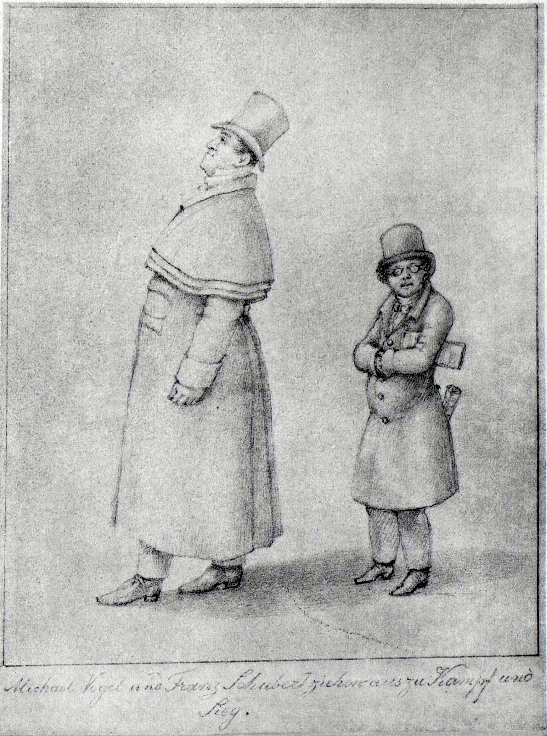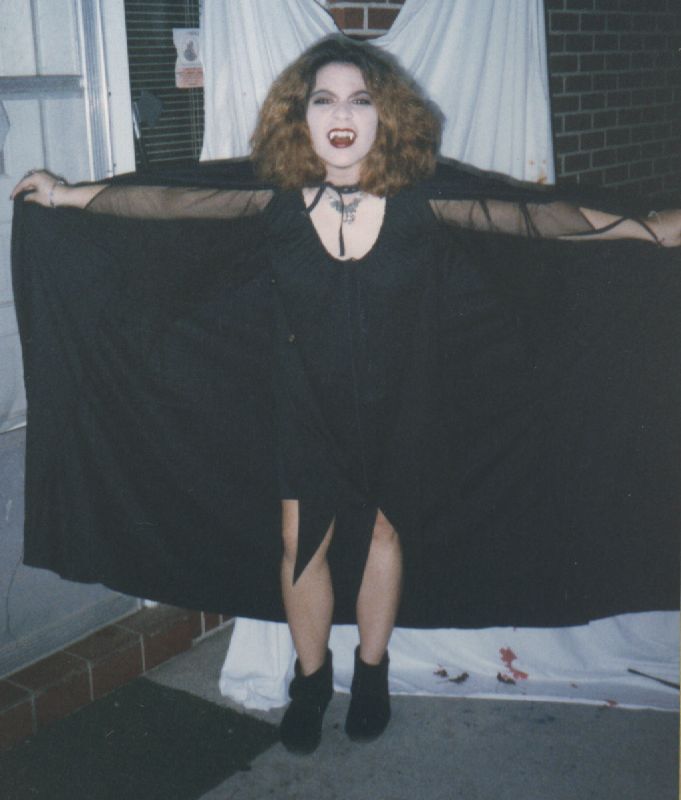|
Unsinnsgesellschaft
The Unsinnsgesellschaft (Nonsenses Society) was a brotherhood of artists in Vienna that met regularly from April 1817 to the end of 1818. Its members included important artists of the Biedermeier period such as August von Kloeber, Johann Nepomuk Hoechle, August Kopisch, Josef Kupelwieser, Josef and Leopold Kupelwieser, and Franz Schubert. All 25-30 members but one, the proprietress of the inn where they met, were men. Although two took women's names within the club, of which still-life painter was known for dressing in women's clothing and wearing Peafowl, peacock feathers. Activities of the Unsinnsgesellschaft The members met once a week, on Thursdays, in the inn "Zum rothen Hahn" at Landstraßer Hauptstraße 40 in Vienna. Archiv des menschlichen Unsinns The handwritten, weekly club magazine ''Archiv des menschlichen Unsinns - ein langweiliges Unterhaltungsblatt für Wahnwitzige'' (Archive of Human Nonsense - a boring entertainment magazine for the insane) contained variou ... [...More Info...] [...Related Items...] OR: [Wikipedia] [Google] [Baidu] |
Joseph Kupelwieser
Joseph Kupelwieser (14 January 1791 – 2 February 1866) was an Austrian playwright, librettist, dramaturge and theatre director. Working at Vienna theatres for decades, he wrote the libretto for Franz Schubert's opera ''Fierrabras''. Biography Kupelwieser was born in Vienna, the son of Johann Kupelwieser (1760–1813), a tinware manufacturer with factories in Markt Piesting, Guntramsdorf and Vienna. From 1801 to 1802, Joseph attended the Akademisches Gymnasium and the Erziehungsinstitut (a boarding school) operated by Gaetano Giannatasio del Rio (1764–1828). He also studied briefly at the K.k. Akademie für Orientalische Sprachen, before becoming a soldier. He ran the factory of his father, which went bankrupt in 1822. In 1812, he married Anna Nödel, and they had at least five children. He was a member of the Unsinnsgesellschaft (''Nonsense Society'') from 1817, a group of painters, actors, writers and musicians (like Franz Schubert), who participated in revelries ost ... [...More Info...] [...Related Items...] OR: [Wikipedia] [Google] [Baidu] |
Franz Schubert
Franz Peter Schubert (; ; 31 January 179719 November 1828) was an Austrian composer of the late Classical period (music), Classical and early Romantic music, Romantic eras. Despite his short life, Schubert left behind a List of compositions by Franz Schubert, vast ''oeuvre'', including more than 600 ''Lieder'' (art songs in German) and other vocal works, seven complete symphonies, sacred music, operas, incidental music, and a large body of piano and chamber music. His major works include "Erlkönig (Schubert), Erlkönig", "Gretchen am Spinnrade", and "Ave Maria (Schubert), Ave Maria"; the Trout Quintet, ''Trout'' Quintet; the Symphony No. 8 (Schubert), Symphony No. 8 in B minor (''Unfinished''); the Symphony No. 9 (Schubert), Symphony No. 9 in C major (''Great''); the String Quartet No. 14 (Schubert), String Quartet No. 14 in D minor (''Death and the Maiden''); the String Quintet (Schubert), String Quintet in C major; the Impromptus (Schubert), Impromptus for solo piano; the S ... [...More Info...] [...Related Items...] OR: [Wikipedia] [Google] [Baidu] |
Leopold Kupelwieser
Leopold Kupelwieser (17 October 1796, Markt Piesting – 17 November 1862, Vienna) was an Austrian painter, often associated with the Nazarene movement. Biography He was the son of Johann Baptist Georg Kilian Kupelwieser (1760–1813), co-owner of a factory that produced tableware.Eva Wald: ''Die Anfänge der Industrie des Wiener Beckens und ihre geographischen Grundlagen''. Vienna University dissertation, 1954Permalink ''Österreichischer Bibliothekenverbund'' pg. 221. His talents were recognized at an early age by the sculptor Franz Anton von Zauner and by the time he was twelve, he was already attending the Academy of Fine Arts, Vienna. During a stay in Rome in 1824, he came under the influence of Friedrich Overbeck and the Nazarene movement. After the death of , a Russian nobleman who had been his patron there, he returned to Vienna and earned his living primarily as an illustrator and portrait painter, although he is also known to have painted shop signs. His brother wa ... [...More Info...] [...Related Items...] OR: [Wikipedia] [Google] [Baidu] |
New Year's Eve
In the Gregorian calendar, New Year's Eve refers to the evening, or commonly the entire day, of the last day of the year, 31 December, also known as Old Year's Day. In many countries, New Year's Eve is celebrated with dancing, eating, drinking, and watching or lighting fireworks. Many Christians attend a watchnight service to mark the occasion. New Year's Eve celebrations generally continue into New Year's Day, January 1, 1 January, past midnight. The local time zone determines the advent of the New Year; the first places to welcome the New Year are west of the International Date Line: the Line Islands (part of Kiribati), Samoa and Tonga, in the Pacific Ocean. In contrast, American Samoa, Baker Island and Howland Island (part of the United States Minor Outlying Islands) are among the last. By region Africa Algeria In Algeria, New Year's Eve is usually celebrated with family and friends. In the largest cities, there are fireworks at midnight. The Martyrs' Memorial, Algiers, Ma ... [...More Info...] [...Related Items...] OR: [Wikipedia] [Google] [Baidu] |
Metaphor
A metaphor is a figure of speech that, for rhetorical effect, directly refers to one thing by mentioning another. It may provide, or obscure, clarity or identify hidden similarities between two different ideas. Metaphors are usually meant to create a likeness or an Analogy, analogy. Analysts group metaphors with other types of figurative language, such as antithesis, hyperbole, metonymy, and simile. According to Grammarly, "Figurative language examples include similes, metaphors, personification, hyperbole, allusions, and idioms." One of the most commonly cited examples of a metaphor in English literature comes from the "All the world's a stage" monologue from ''As You Like It'': All the world's a stage, And all the men and women merely players; They have their exits and their entrances And one man in his time plays many parts, His Acts being seven ages. At first, the infant... :—William Shakespeare, ''As You Like It'', 2/7 This quotation expresses a metaphor because the w ... [...More Info...] [...Related Items...] OR: [Wikipedia] [Google] [Baidu] |
Comedy
Comedy is a genre of dramatic works intended to be humorous or amusing by inducing laughter, especially in theatre, film, stand-up comedy, television, radio, books, or any other entertainment medium. Origins Comedy originated in ancient Greece: in Athenian democracy, the public opinion of voters was influenced by political satire performed by comic poets in Ancient Greek theatre, theaters. The theatrical genre of Greek comedy can be described as a dramatic performance pitting two groups, ages, genders, or societies against each other in an amusing ''agon'' or conflict. Northrop Frye depicted these two opposing sides as a "Society of Youth" and a "Society of the Old". A revised view characterizes the essential agon of comedy as a struggle between a relatively powerless youth and the societal conventions posing obstacles to his hopes. In this struggle, the youth then becomes constrained by his lack of social authority, and is left with little choice but to resort to ruses which e ... [...More Info...] [...Related Items...] OR: [Wikipedia] [Google] [Baidu] |
Literature
Literature is any collection of Writing, written work, but it is also used more narrowly for writings specifically considered to be an art form, especially novels, Play (theatre), plays, and poetry, poems. It includes both print and Electronic literature, digital writing. In recent centuries, the definition has expanded to include oral literature, much of which has been transcribed.; see also Homer. Literature is a method of recording, preserving, and transmitting knowledge and entertainment. It can also have a social, psychological, spiritual, or political role. Literary criticism is one of the oldest academic disciplines, and is concerned with the literary merit or intellectual significance of specific texts. The study of books and other texts as artifacts or traditions is instead encompassed by textual criticism or the history of the book. "Literature", as an art form, is sometimes used synonymously with literary fiction, fiction written with the goal of artistic merit, but ... [...More Info...] [...Related Items...] OR: [Wikipedia] [Google] [Baidu] |
Fang Des Fisches Und Des Frosches
A fang is a long, pointed tooth. In mammals, a fang is a modified maxillary tooth, used for biting and tearing flesh. In snakes, it is a specialized tooth that is associated with a venom gland (see snake venom). Spiders also have external fangs, which are part of the chelicerae. Fangs are most common in carnivores or omnivores, but some herbivores, such as fruit bats, have them as well. They are generally used to hold or swiftly kill prey, such as in large cats. Omnivorous animals, such as bears, use their fangs when hunting fish or other prey, but they are not needed for consuming fruit. Some apes also have fangs, which they use for threats and fighting. However, the relatively short canines of humans are not considered to be fangs. Fangs in religion, mythology and legend Certain mythological and legendary creatures such as dragons, gargoyles, demons and yakshas are commonly depicted with prominent fangs. The fangs of vampires are one of their defining characteristics. The ico ... [...More Info...] [...Related Items...] OR: [Wikipedia] [Google] [Baidu] |
Party
A party is a gathering of people who have been invited by a Hospitality, host for the purposes of socializing, conversation, recreation, or as part of a festival or other commemoration or celebration of a special occasion. A party will often feature food and beverages, and often conversation, music, dancing, or other forms of entertainment. Some parties are held in honor of a specific person, day, or event, such as a birthday party, a Super Bowl party, or a St. Patrick's Day party. Parties of this kind are often called celebrations. A party is not necessarily a private occasion. Public parties are sometimes held in restaurants, Public house, pubs, beer gardens, nightclubs, or Bar (establishment), bars, and people attending such parties may be charged an admission fee by the host. Large parties in public streets may celebrate events such as Mardi Gras or the signing of a peace treaty ending a long war. Types Balls Banquets Birthday party A birthday party is a celeb ... [...More Info...] [...Related Items...] OR: [Wikipedia] [Google] [Baidu] |
Anniversary
An anniversary is the date on which an event took place or an institution was founded. Most countries celebrate national anniversaries, typically called national days. These could be the List of national independence days, date of independence of the nation or the adoption of a new constitution or form of government. There is no definite method for determining the date of establishment of an institution, and it is generally decided within the institution by Convention (norm), convention. The important dates in a sitting monarch's reign may also be commemorated, an event often referred to as a "jubilee". Names * Birthdays are the most common type of anniversary, on which someone's birthdate is commemorated each year. The actual celebration is sometimes moved for practical reasons, as in the case of an official birthday or one falling on February 29. * Wedding anniversary, Wedding anniversaries are also often celebrated, on the same day of the year as the wedding occurred. * De ... [...More Info...] [...Related Items...] OR: [Wikipedia] [Google] [Baidu] |










